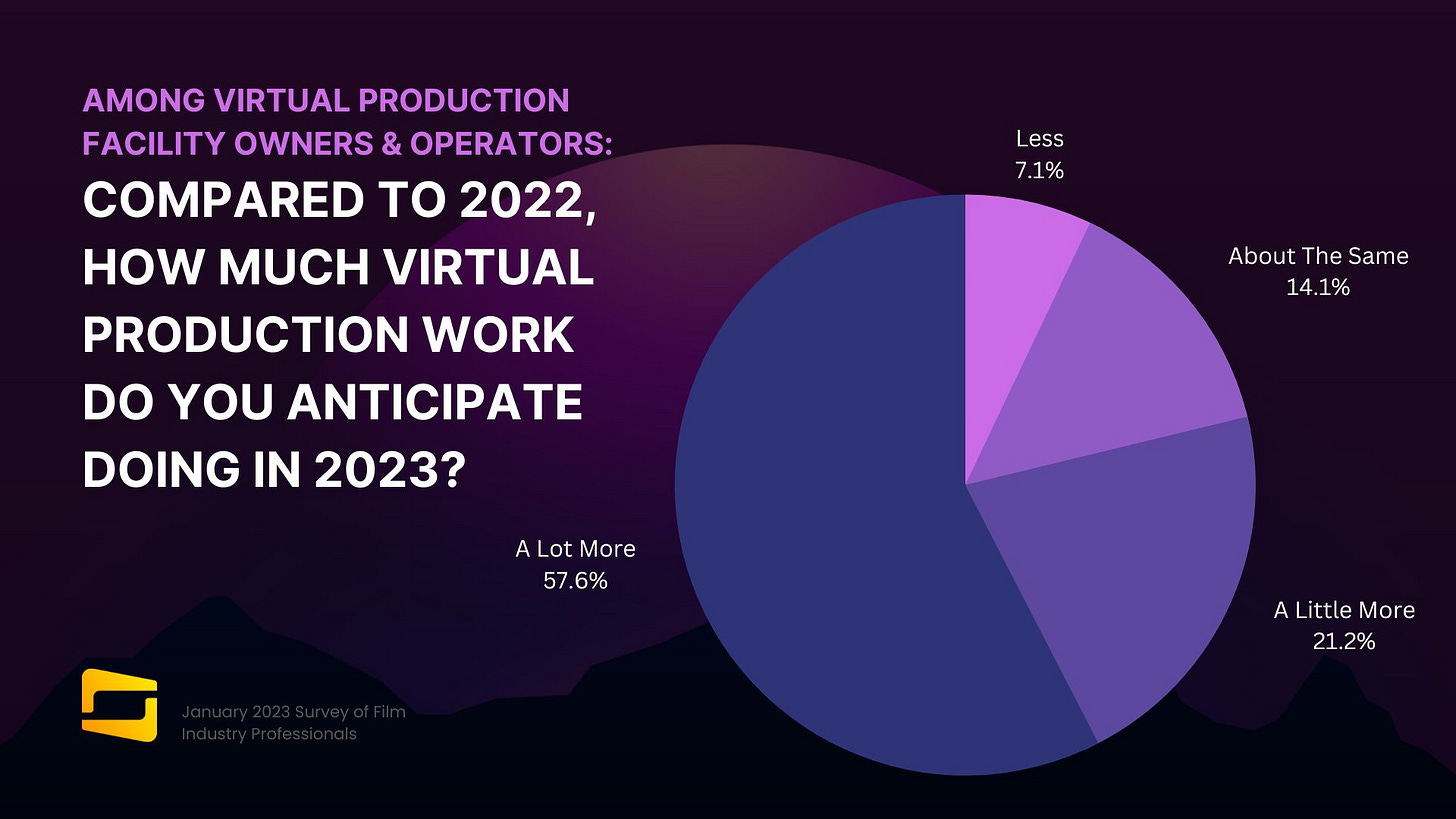State of VP 2023: Attitudes Toward Virtual Production
As part of our mission to understand the Virtual Production landscape as it stands at the top of the year, we (film tech company SHOWRUNNER) conducted a set of online surveys in January 2023:
A survey of 771 film industry professionals in Los Angeles; and
A survey of 72 virtual production studio owners and operators across North America and the Europe.
While virtual production (VP) is still an emerging industry, the results point to a general excitement and openness to its adoption. However, plenty of filmmakers are also wary of high initial costs for technology that leaves some things to be desired. Below are some of the most striking takeaways gleaned from the survey.
Overall Excitement In The Promise of Virtual Production
When asked how they felt about the rise of VP in the film industry, 53.4% of the professionals surveyed reported feeling excited about it. Overall, virtual production is being embraced by those in the industry as well as viewers.
And the excitement just increases the more experience filmmakers seem to have in virtual production.
Only 23% of those surveyed said they anticipated having no virtual production work in 2023. Even those who aren't exclusively working in VP are very likely to end up involved in VP work in some capacity this year.
The Two Biggest Keywords About The Specifics Of Virtual Production: "Not Sure"
35.1% of respondents believe VP is technically difficult, but about 43.8% are not sure if it's difficult.
We've heard a recurring experience from filmmakers, which is that they're by and large excited about VP, but have no idea what to do once they're confronted with the technology and equipment.
Is VP faster? Higher quality? Less expensive? The most common response to these questions is a resounding, "Not sure."
Shooting with Rear Projection has been a practice for a while, which makes shooting VP seem intuitive to many at first. However, there are plenty of unintuitive snags that filmmakers run into in order to master VP—the sort of technical knowledge that is impossible to guess or troubleshoot without some program-specific training and understanding.
The film industry as a whole may be charging forth into VP with a fair amount of naiveté—which makes VP tech solutions that are intuitive and easy to use all the more valuable.
What The Producers Are Saying About Virtual Production
As with any technological advancement, the expectation is that some producers naturally find it thrilling and liberating, while others are more hesitant to jump on board. Among excited adopters, we heard about the revolutionary capabilities that VP will provide.
The skeptics are naturally concerned about the cost and newness of it all. While the initial VP spend is prohibitive to some, other filmmakers say that the overall return on investment makes VP cost-efficient in the long run.
Tech That Leaves Some To Be Desired
While some VP tech systems like outside-in tracking are favored among filmmaking professionals with a year or more of VP experience, some of the current technologies in place aren't up to snuff. Most of survey participants, in fact, are currently unsatisfied with the state of real-time rendering technology, and most participants are unsatisfied with the current state of virtual production workflow tools.
As an increasing number of filmmakers turn to VP capabilities, tech developers are going to be tasked with meeting the demand and improving upon existing solutions.
Upcoming Virtual Production Projects
When asked what sort of VP work production facility owners and operators anticipate doing during the upcoming years, nearly one-third said car commercials. When combined, film and TV make up the largest category at just under 40 percent.
While it isn't entirely likely that there will be a similar amount of auto commercial and narrative film or TV work, it's also interesting to gauge these survey results as hopeful projections based on filmmakers' interests. The results point to increased interest in more VP film and TV, and hope that producers will rise to meet the demand.
Similarly, when we asked this group how much virtual production work they anticipated doing this year, 57.6 percent said: "a lot more." Whether they actually plan to do a lot more VP work or just hope this will be the case, the interest in a higher concentration of VP projects remains.
But strikingly, more than three-fourths of respondents said they would likely do at least a little more VP work this year than last.
When asked if they could "wave a magic wand and change one thing about the virtual production industry," results were fairly expected for an industry as nascent as VP. Respondents reported wanting more buy-in from producers, increased adoption, and lower hardware costs. Overall, the survey pointed to a general enthusiasm for VP from filmmakers, coupled with some pauses and hesitations about cost and the current available tech systems.
Want to see the results and our additional conclusions? Download a copy of the full report here.













